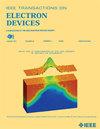Development of Fully ZnO-Based 16 × 16 1S1R RRAM Crossbar Array and Performance Investigations
IF 2.9
2区 工程技术
Q2 ENGINEERING, ELECTRICAL & ELECTRONIC
引用次数: 0
Abstract
This study investigates the effects of co-sputtering SiC into zinc oxide (ZnO):Li (3 mol%) thin films, resulting in the formation of lithium-doped zinc oxide: silicon carbide (LZO:SiC) oxide layers. These oxide layers have different work functions (WFs) due to their distinct chemical bonding. Subsequently, these layers are stacked together to form a form-free one-selector and one-resistor (1S1R) structure. This structure comprises Pt/V/LZO:SiC2 (buffer layer)/LZO:SiC1 (oxide layer)/TiN. Notably, this marks the first successful production of a ZnO-based 1S1R structure using this method. In our experiments, we observed that this novel structure significantly enhances I–V nonlinearity, increasing it from the initial value of 2.14–62. Furthermore, according to our calculations, the optimal array size has substantially increased from the original 4 bits to over 2500 bits, indicating the enormous potential of this technology for high-density memory applications. Building on these results, we further utilized photomask manufacturing technology to successfully create a全zno基16 × 16 1S1R RRAM横杆阵列的研制及性能研究
本研究研究了SiC共溅射成氧化锌(ZnO):Li (3mol %)薄膜,从而形成掺杂锂的氧化锌:碳化硅(LZO:SiC)氧化物层的影响。由于不同的化学键,这些氧化层具有不同的功函数。随后,这些层堆叠在一起,形成无形式的一个选择器和一个电阻(1S1R)结构。该结构由Pt/V/LZO:SiC2(缓冲层)/LZO:SiC1(氧化层)/TiN组成。值得注意的是,这标志着使用这种方法首次成功生产了基于zno的1S1R结构。在我们的实验中,我们观察到这种新结构显著增强了I-V非线性,使其从初始值2.14-62增加。此外,根据我们的计算,最佳阵列大小已经从原来的4位大幅增加到2500位以上,这表明该技术在高密度存储器应用中的巨大潜力。在此基础上,我们进一步利用光掩模制造技术成功地制造了一个16\ × 16~1$ S1R的电阻随机存取存储器(RRAM)交叉棒阵列。据我们所知,这是将基于zno的1S1R结构应用于交叉棒阵列的第一份报告。这项研究不仅证明了基于zno的1S1R结构的可行性,而且为高性能存储技术的未来应用开辟了新的方向。我们的发现展示了该技术的潜在优势,并为进一步的技术开发和实际应用提供了坚实的基础。
本文章由计算机程序翻译,如有差异,请以英文原文为准。
求助全文
约1分钟内获得全文
求助全文
来源期刊

IEEE Transactions on Electron Devices
工程技术-工程:电子与电气
CiteScore
5.80
自引率
16.10%
发文量
937
审稿时长
3.8 months
期刊介绍:
IEEE Transactions on Electron Devices publishes original and significant contributions relating to the theory, modeling, design, performance and reliability of electron and ion integrated circuit devices and interconnects, involving insulators, metals, organic materials, micro-plasmas, semiconductors, quantum-effect structures, vacuum devices, and emerging materials with applications in bioelectronics, biomedical electronics, computation, communications, displays, microelectromechanics, imaging, micro-actuators, nanoelectronics, optoelectronics, photovoltaics, power ICs and micro-sensors. Tutorial and review papers on these subjects are also published and occasional special issues appear to present a collection of papers which treat particular areas in more depth and breadth.
 求助内容:
求助内容: 应助结果提醒方式:
应助结果提醒方式:


